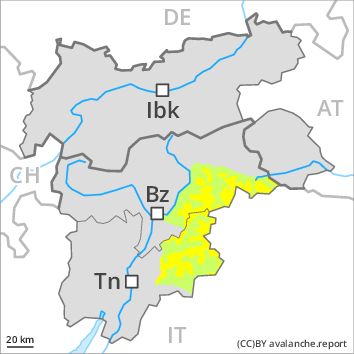Regions
Gröden Dolomites, Primiero - Pale di S. Martino, Prags Dolomites, Fassa Valley, Southern Lagorai, Sexten Dolomites, Northern Lagorai, Latemar
AM

Danger level
Danger Level 2 - Moderate above 2400m
Danger Level 1 - Low above 2400m
Avalanche Problem
Wind-drifted snow above 2400m, N-NE-E-NW
PM

Danger level
Danger Level 2 - Moderate above 2400m
Danger Level 2 - Moderate above 2400m
Avalanche Problem
Wet snow above 2400m, N-NE-E-SE-S-SW-W-NW
Wind-drifted snow above 2400m, N-NE-E-NW
The danger of moist and wet avalanches will increase during the day.
The Avalanche Warning Service currently has only a small amount of information that has been collected in the field.
Early morning: More recent wind slabs represent the main danger. These can in some places be released, in particular by large loads and reach medium size.
During the day: As a consequence of warming during the day and the solar radiation, the likelihood of wet and gliding avalanches being released will increase gradually in all aspects.
Snowpack
dp 6: cold, loose snow and wind
The surface of the snowpack will freeze to form a strong crust and will soften during the day. The fresh wind slabs are lying on weak layers in particular on shady slopes above the tree line. They remain in some cases prone to triggering in particular on very steep shady slopes. The weather will be mostly sunny.
Tendency
Slow warming: Further increase in danger of moist avalanches as a consequence of solar radiation.
Regions
Val Müstair Alps, Langtaufers, Schnals Ridge, Southern Stubai Alps, Southern Zillertal Alps and High Tauern, Saldurn-Mastaun Ridge, Texel Mountains, Sarntal Alps, Western Pfunderer Mountains, Bondone and Stivo, Folgaria - Laverone, Maddalene, Pine' - Mocheni Valley, Eastern Pfunderer Mountains, Durreck Range, Western Rieserferner Mountains, Western Deferegger Alps, Ortler Range, Ulten Valley, Eastern Nonsberger Alps, Northern Dolomites of Fiemme, Prealps, Cembra Valley, Vallarsa, Western Nonsberg Alps, Sole, Pejo and Rabbi, Marzola - Valsugana
AM

Danger level
Danger Level 1 - Low
PM

Danger level
Danger Level 2 - Moderate
Avalanche Problem
Wet snow above 2400m, N-NE-E-SE-S-SW-W-NW
Wet avalanches as the day progresses.
The Avalanche Warning Service currently has only a small amount of information that has been collected in the field.
The older wind slabs can in some cases be released, mostly by large loads and reach medium size. This applies in particular on very steep shady slopes as well as adjacent to ridgelines and in pass areas at high altitudes and in high Alpine regions.
As a consequence of the solar radiation, the likelihood of moist and wet avalanches being released will increase gradually. As the day progresses small and, in isolated cases, medium-sized moist and wet avalanches are possible below approximately 2400 m.
Snowpack
dp 10: springtime scenario
Outgoing longwave radiation during the night will be good over a wide area. The surface of the snowpack will freeze to form a strong crust and will soften during the day. Isolated avalanche prone weak layers exist in the old snowpack especially on very steep shady slopes.
Tendency
Further increase in danger of moist and wet avalanches as a consequence of warming during the day and solar radiation.



